Marketing Concepts for Social Media
- Concepts of raising brand awareness.
- Maintaining communication with the target audience.
- Creating product involvement and brand recognition.
- Concept of building conversions to increase profits.
- Forming social identities and the decision-making process.
- Making positive brand association through interaction.
Social media marketing is a significant procedure, and its concepts are largely based on modern approaches to the organization of interaction with customers on the Internet. According to Tuten and Solomon, different concepts form this concept, including brand awareness, conversion build-up, and other significant aspects (49). In Figure 1 presented by Wunderboom Marketing et al., it is possible to see that modern advertising affects all the important resources that people use today. These intersections prove the relevance of social media marketing and the diversity of its aspects. The key objectives of interventions are to create a positive image for specific products and to engage the target audience.
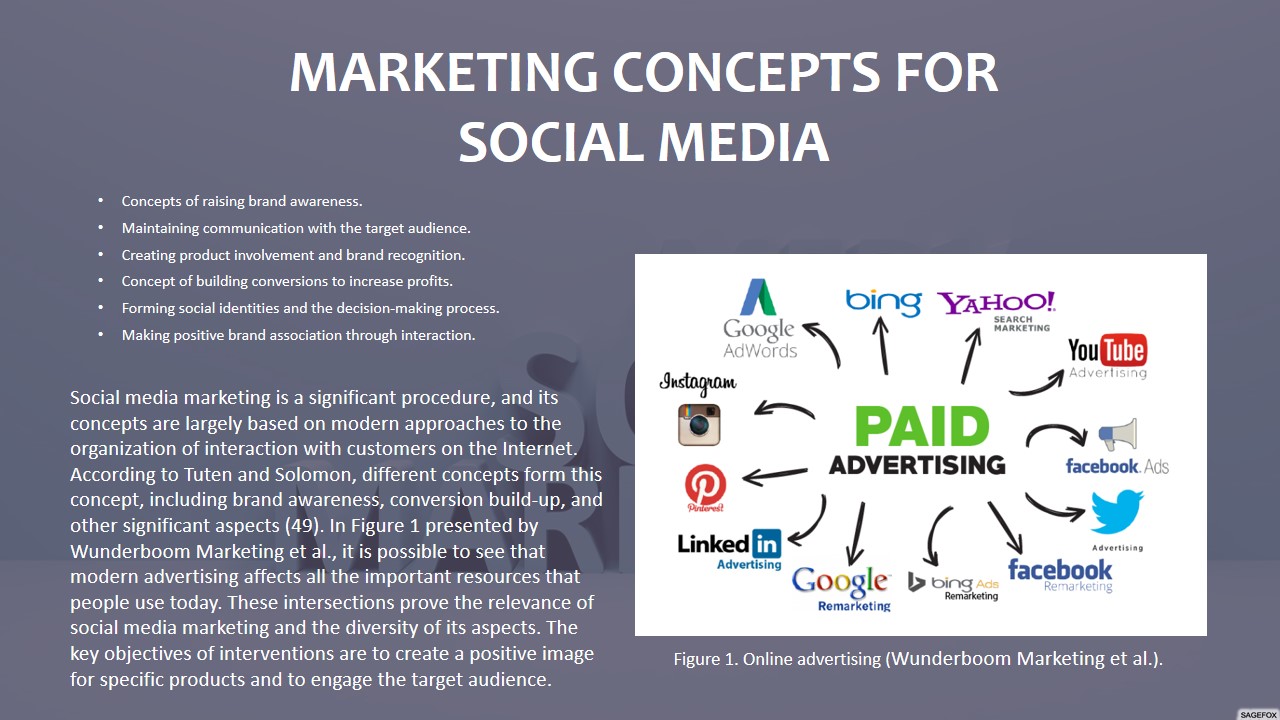
Brand Communication in Social Media
- Promoting a particular brand among different users.
- Modern advertising methods – bonuses, prizes, and other mechanisms.
- Setting the value of the brand for the target audience.
- Tracking user activity in real time.
- Sales and advertising are available on the same platform.
- A wide range of advertising integration techniques.
Brand communication provides an opportunity to promote certain products through special mechanisms that allow distributing promotional materials among the target audience. According to Tuten and Solomon, the relationship between goods or services and the growth of their sales depends on the quality of promotional work conducted online (64). Today, many opportunities for product distribution exist among different groups of users on social networks. As a result, sales as the main objective of marketing increase due to a positive attitude towards a particular brand.
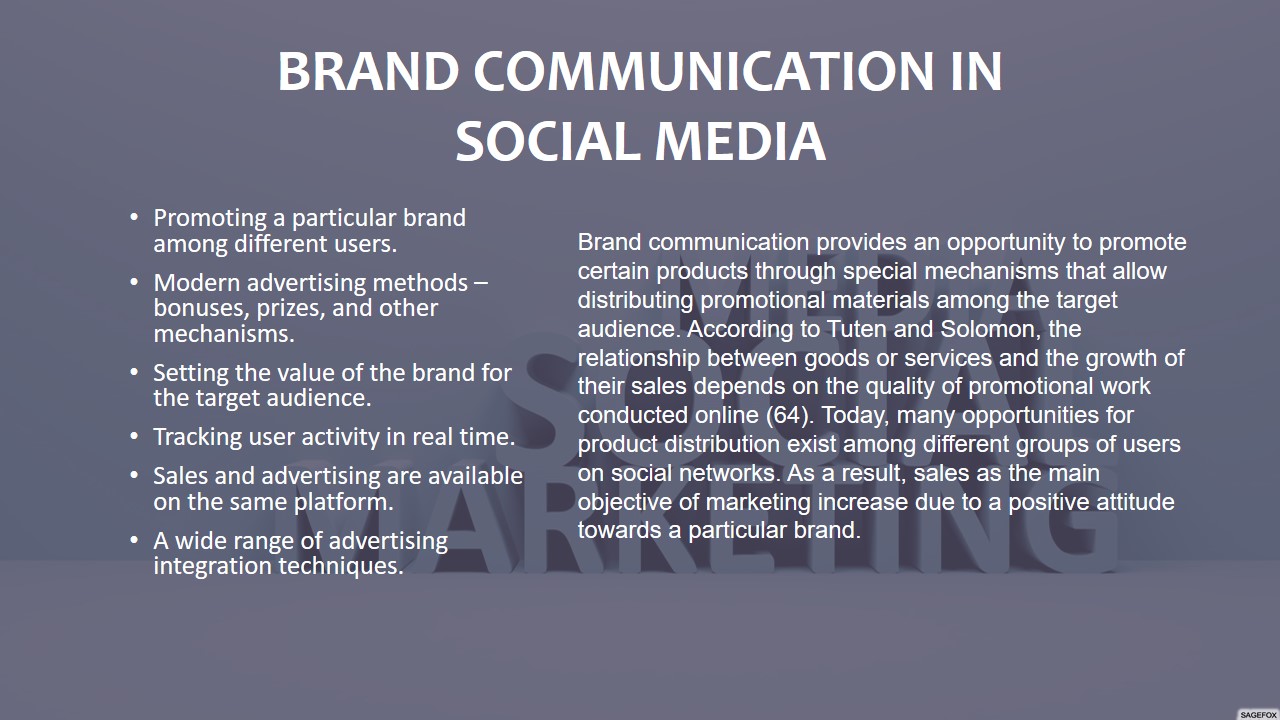
Social Media Strategies
- Identifying the most popular search area.
- The knowledge of the interests of the target audience and their preferences contributes to ensuring the demand for certain goods and helps to find the most effective ways of goods distribution (“Importance of Social Media Marketing”).
- Engaging the audience through direct interaction.
- Contact with potential buyers on social networks makes it possible to increase their confidence in the availability of communication and enhances interest in certain products due to clients’ trust (“Importance of Social Media Marketing”).
- Capturing public attention through lucrative offers.
- This methods helps promote certain goods and not lose interest among potential buyers (“Importance of Social Media Marketing”).
- Boosting brand awareness through continuous customer engagement.
- In Figure 2, the mechanism of involving new clients is demonstrated (“Importance of Social Media Marketing”).
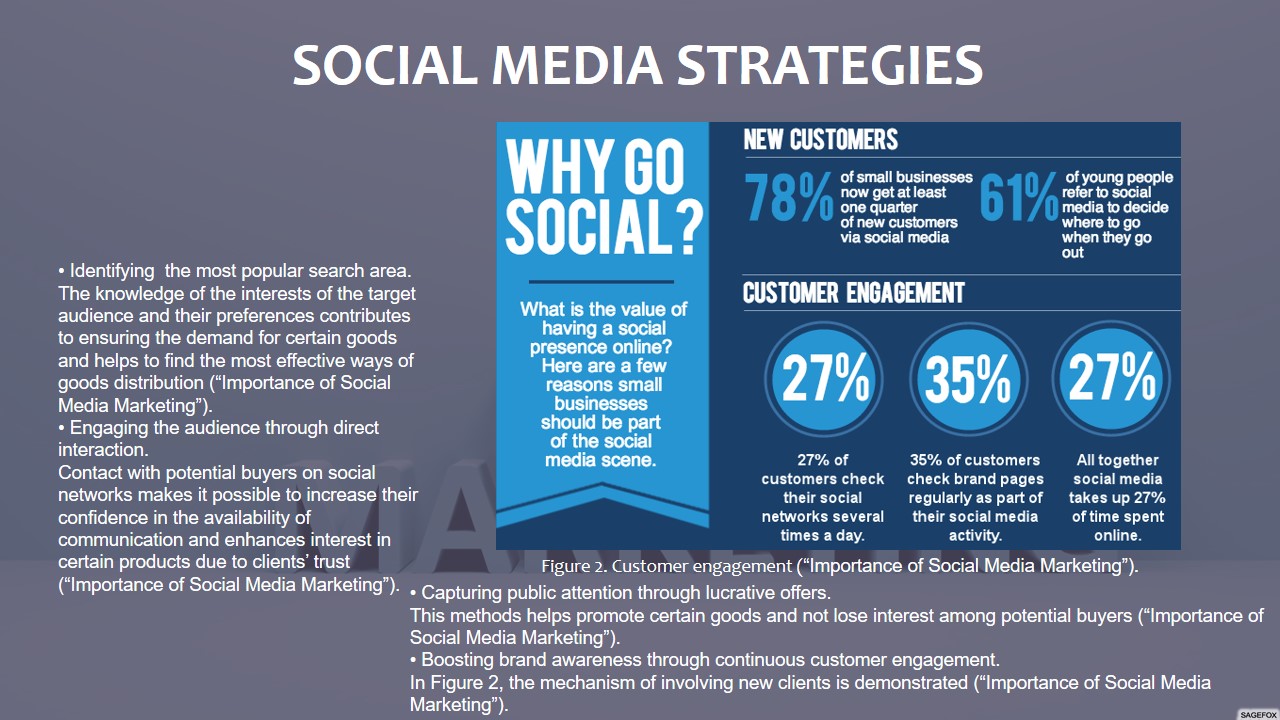
Trust as a Marketing Objective
- Demand largely depends on the target audience’s trust.
- Social marketing providers rely on customer trust.
- Using appropriate practices increasing confidence in the brand is welcome.
- The loss of trust is fraught with the lack of demand.
- Confidence in goods or services stimulates engaging new consumers.
- Products with a high degree of confidence occupy leading market positions.
An opportunity to earn customer trust is one of the main objectives of social media marketing. According to Wang et al., “SMPs providers are dependent upon the ability to cultivate trust with member” (36). Since the expansion of the target audience helps to increase sales and, consequently, enhance profits, clients’ credibility is of great importance for sellers and those who are involved in the distribution of promotional materials in social media.
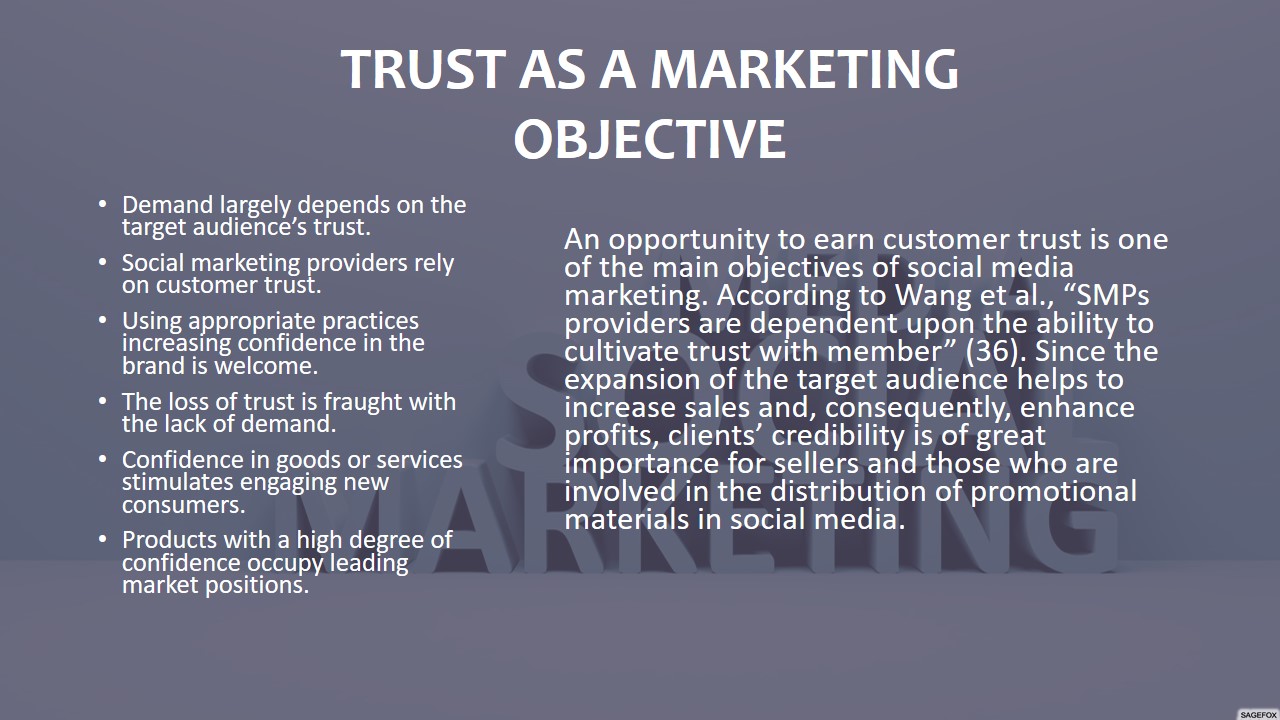
Trust Management in Social Media
- Trust management influences consumer behavior.
- Competent trust control correlates with demand positively.
- The lack of measures to monitor customer confidence is fraught with sales risks.
- Buyers purchase goods more willingly if they feel the protection of the brand’s reputation.
- The assessment of the quality of trust management depends on sales stability.
- Bringing trust management strategies stimulates risk protection.
Findings from academic studies prove that trust management has a positive effect on customer behavior and consumer shopping habits (Wang et al. 37). Moreover, engaging appropriate tactical measures to maintain a high level of the monitoring of such a variable stimulates clients’ confidence in a particular brand and creates favorable background for introducing additional involvement practices. Therefore, trust management plays a significant role in the context of social media marketing.

Image and Reputation as Marketing Objectives
- Reputation is a collective concept in social media marketing.
- The image of a particular brand is created by a number of variables.
- Timely reporting, reliability, the quality of communication, and other features are taken.
- The concept of reputation is closely related to trust.
- The lack of a positive image leads to the lack of demand.
- Overcoming risks is largely due to good reputation.
Like trust, positive reputation is the phenomenon that contributes to the growth of customer appreciation. As Ott and Theunissen note, the image of a certain brand is created from a number of variables, and the higher their level is, the more successful is an advertising program (97). As a result, those online resources that are able to create a stable base of grateful customers have significantly higher positions compared with platforms that do not have a proper image.

Reputation Management
- A number of variables are involved in reputation management.
- Quality control requires constant participation.
- Reputation strategies are based on creating customer-oriented offers.
- Managing the image of online sales platforms requires assessing market interests.
- Approaches to maintaining high reputation depend on the specifics of products or services.
- The evaluation of competing firms’ activities is mandatory.
Many factors are taken into account – “perceptions of credibility, reliability, accountability, trustworthiness and competence” (Ott and Theunissen 97). As a result, the required conditions for maintaining a positive image include a set of measures aimed at preserving reputation (some of them are noted in Figure 3) and, consequently, overcoming a competitive barrier. In this regard, it is essential to monitor what approaches other online resources utilize. This will provide an opportunity to outpace competition and have a higher market position, which are the inevitable factors of successful and profitable online marking in social media.
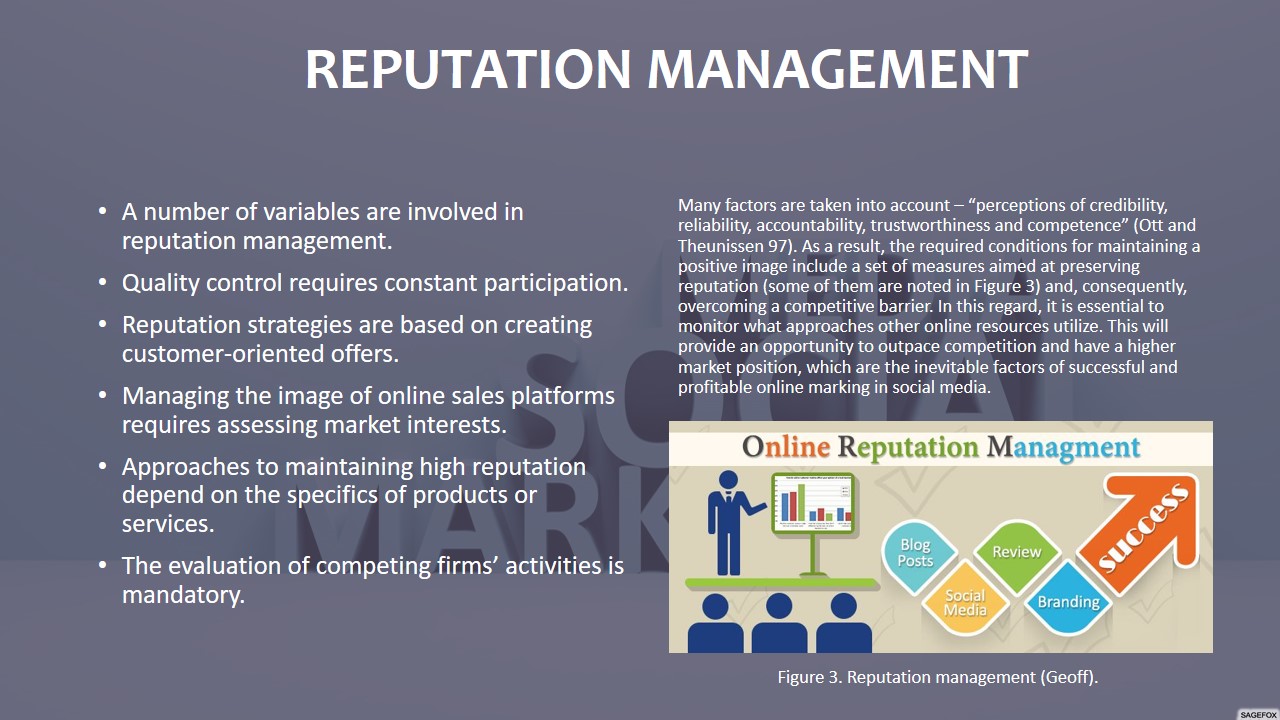
Social Media Categories
- Two types of social media are platforms and tools.
- Social media platforms include technology or software that enable communication.
- The advantage of this category – the content is generated by the users themselves.
- The downside is the lack of full control over interaction.
- Social media tools stimulate user interest in communication.
- Different forms of tools exist today.
The division of social media into categories determines the type of interaction and the ways to which users resort. Platforms are ready sites for communication and include special software and data transfer mechanisms. Tools are those mechanisms that facilitate communication but are not the direct means of interaction. Further discussion of social media tools may allow understanding their specifics and types better to be aware of their significance in modern digital sphere.
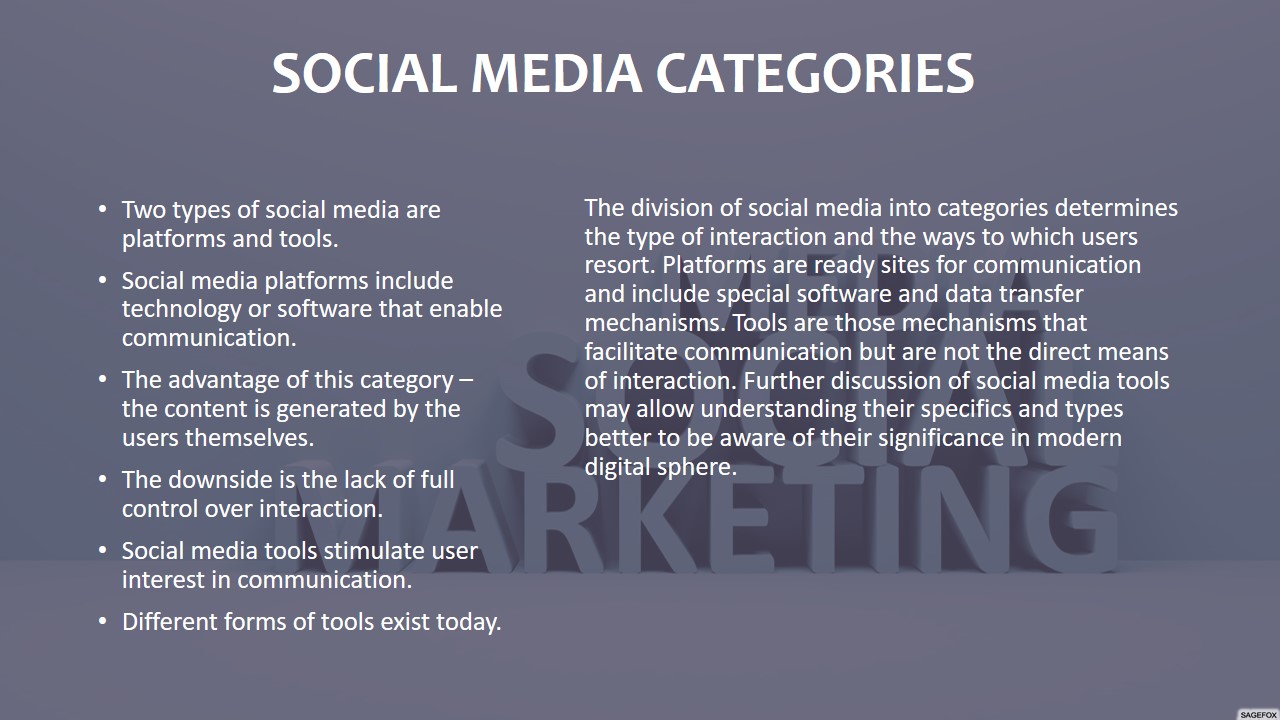
Marketing Tools in Social Media
E-Mail and Mobile Media
- E-mailing is one of the promotional tools.
- Most Internet users have individual addresses and read the newsletter.
- The method allows notifying customers about current offers.
- Mobile media make it possible to convey information to potential clients at any time.
- Internet access allows utilizing mobile media efficiently.
- Different types of promotional offers are available for mobile distribution.
Both e-mailing and mobile media are effective tools for interacting with the target audience. In Figure 4, the possible types of these mechanisms are presented, as well as the online platforms involved in this practice. Due to users’ constant access to the Internet, providers can distribute relevant advertising offers continuously and control convenient moments, which improves the quality of promotional work and contributes to establishing close contact among all the stakeholders.
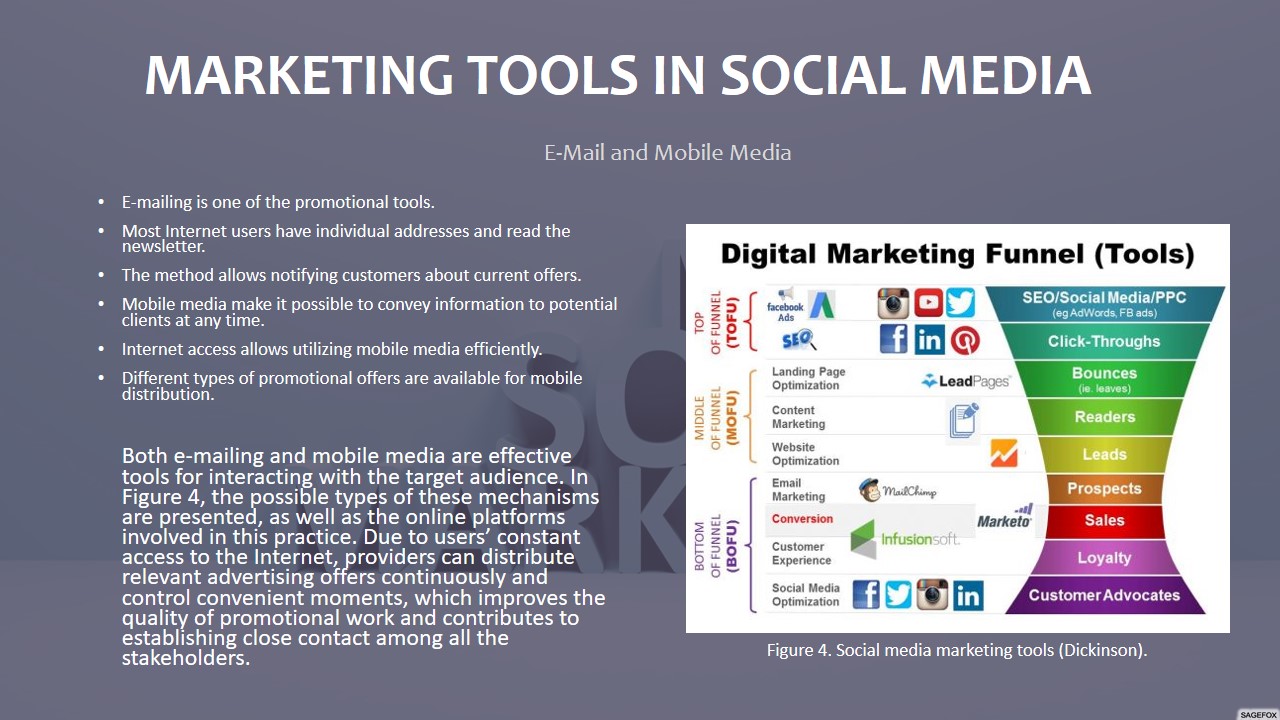
Viral Marketing
- Viral marketing is a relevant modern practice.
- Engaging as many customers as possible is the main goal.
- The distribution of information through various media mechanisms.
- Integration into the most common media platforms.
- The stimulation of data exchange among users.
- Direct impact on the decision-making process.
Viral marketing is one of the most common forms of promotional work in the modern Internet space. According to Gunawan and Huarng, this type of advertising has received its name due to its similarity with viruses that spread very quickly and affect as many people as possible (2237). One of the main advantages of this marketing principle is its rather low cost because viral advertising materials are usually distributed by users themselves, which does not require additional expenses from marketing specialists. The most important task is creating a trend that can develop into a global promotion product.
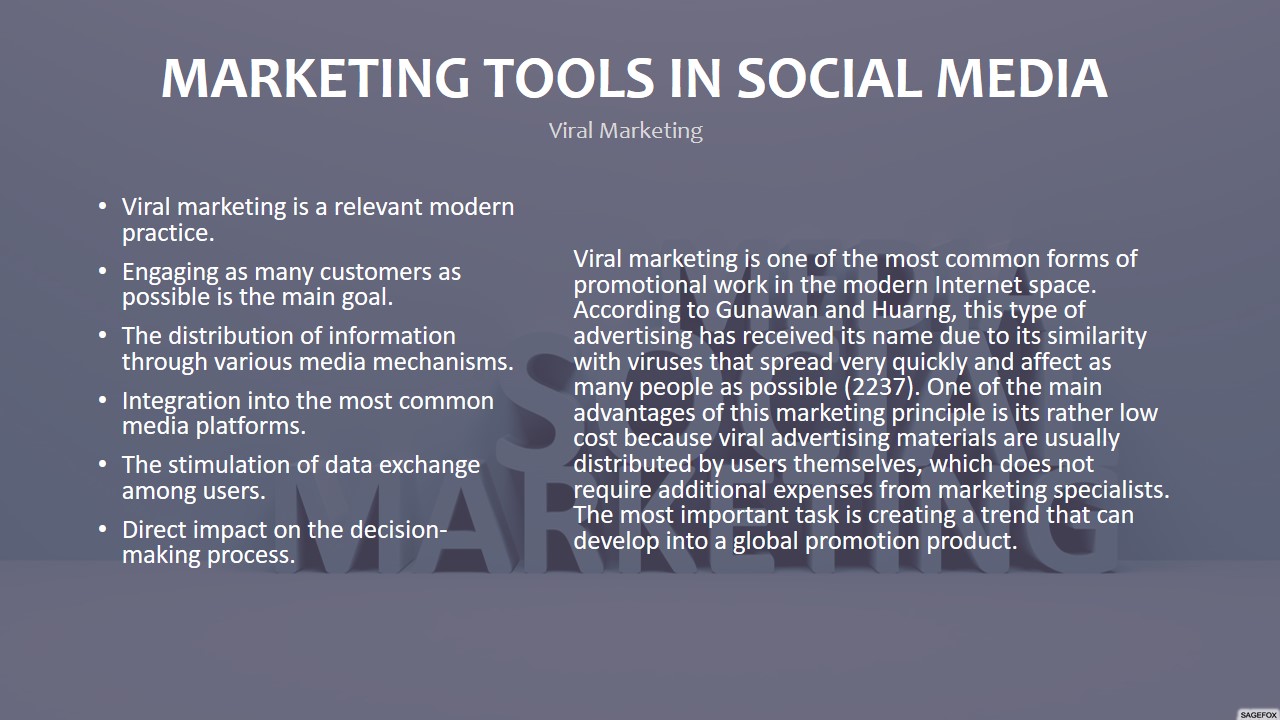
Social Gaming and Social Media Branding
- The method of integrating advertising into online games is common.
- Affiliate agreements allow using popular games to post promotional material.
- Users can receive free access to advertising content.
- Social media branding is used to promote various products and services.
- The interactivity of this method attracts many potential buyers.
- Creating an advertising base increases customer purchase intentions.
An advertising practice in the field of social gaming is a successful mechanism. According to Chen et al., displaying promotional content in the most common user applications stimulates clients’ decision-making process (1). Another principle of modern customer engagement is social media branding. As Gao and Feng argue, in case of the successful involvement of the audience, brand awareness increases due to client confidence and the stability of demand (869). As a result, both the tools considered are relevant in today’s social media environment.
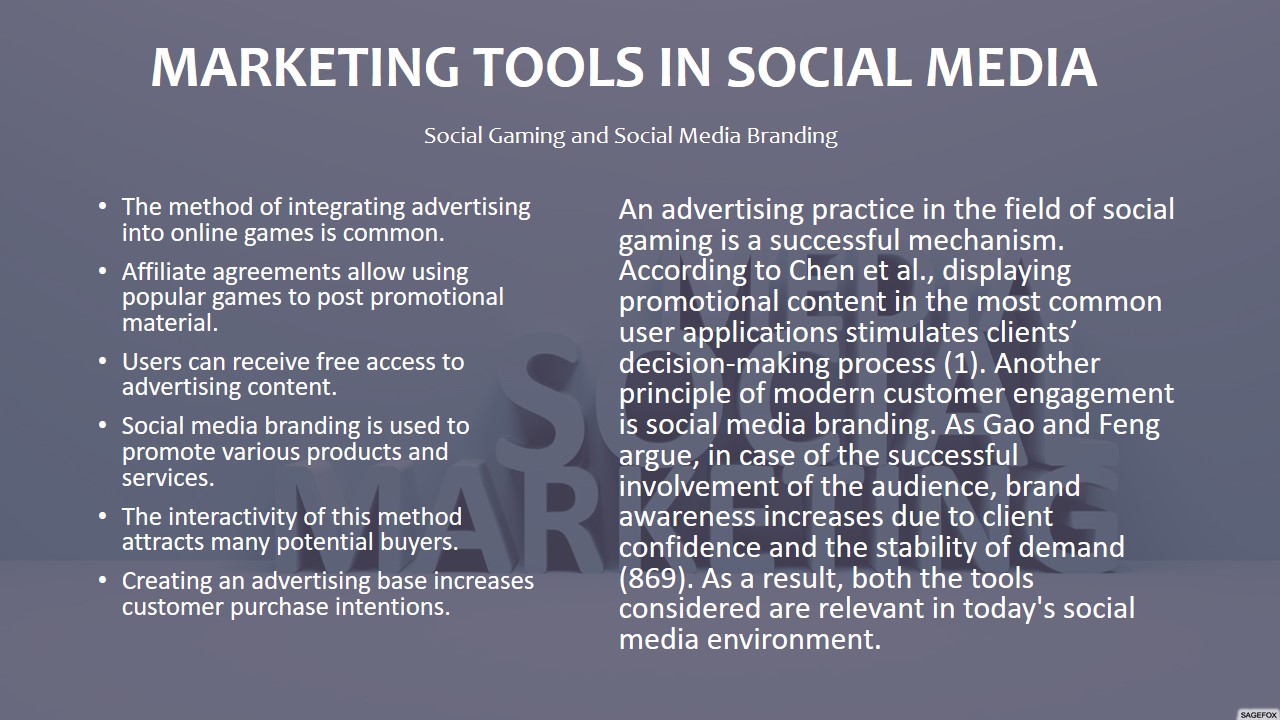
Cross-Media Linkage of Instruments
- The presented social media marketing tools may overlap.
- Using several mechanisms increases the likelihood of promotional work success.
- The quality of implemented strategies influences demand directly.
- Viral promotional materials are successful due to effective integration and placement.
- Social media branding is impossible without accompanying steps.
- Utilizing modern Internet capabilities increases the potential of advertising.
Despite the uniqueness of each of the considered social media tools, their linkage is a natural phenomenon. For instance, work aimed at distributing promotional materials through e-mailing is impossible without prior integration and creating partnership agreements. Branding is of great importance for marketers, and to enhance the effect of involvement, accompanying mechanisms are used, for example, the popularization of certain goods or services through the gaming space. Therefore, it is possible to confirm the cross media linkage of the instruments considered.
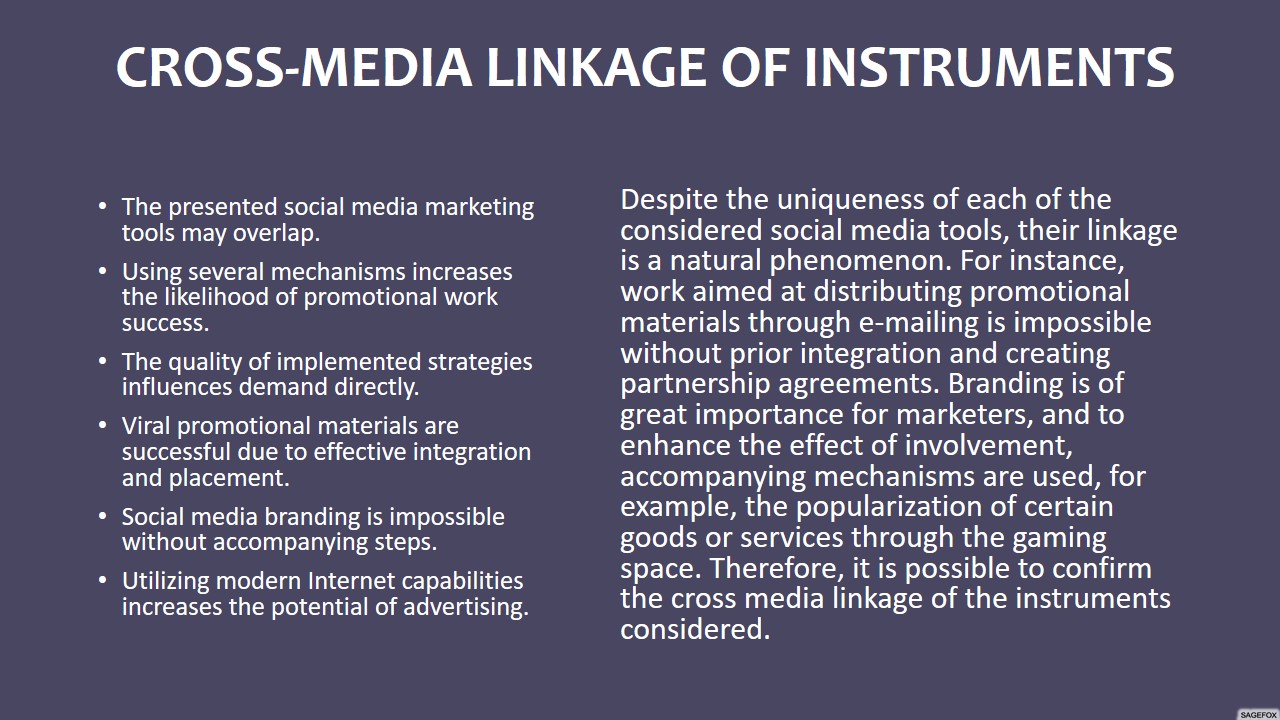
Works Cited
Chen, Hui, et al. “An Extended Technology Acceptance Model for Mobile Social Gaming Service Popularity Analysis.” MobileInformationSystems, vol. 2017, pp. 1-12.
Dickinson, Peter. “Cooler Insights – 2019 Digital marketing funnel channels and tools.” KUB. 2019. Web.
Gao, Qin, and Chenyue Feng. “Branding with Social Media: User Gratifications, Usage Patterns, and Brand Message Content Strategies.” ComputersinHumanBehavior, vol. 63, 2016, pp. 868-890.
Geoff. “Online Reputation Management Services and the Role of Social Media.” Spews. 2018. Web.
Gunawan, Dedy Darsono, and Kun-Huang Huarng. “Viral Effects of Social Network and Media on Consumers’ Purchase Intention.” JournalofBusinessResearch, vol. 68, no. 11, 2015, pp. 2237-2241.
“Importance of Social Media Marketing to business in Kenya (2019).” Pryton Technologies. Web.
Ott, Larissa, and Petra Theunissen. “Reputations at Risk: Engagement During Social Media Crises.” PublicRelationsReview, vol. 41, no. 1, 2015, pp. 97-102.
Tuten, Tracy L., and Michael R. Solomon. SocialMediaMarketing. Sage, 2017.
Wang, Yanbo, et al. “Understanding the Effects of Trust and Risk on Individual Behavior Toward Social Media Platforms: A Meta-Analysis of the Empirical Evidence.” ComputersinHumanBehavior, vol. 56, 2016, pp. 34-44.
Wunderboom Marketing, et al. “Online Paid Advertising – What Are the 3 Types, and How Do You Get It Set-up and Running.” Wunderboom, 2018. Web.